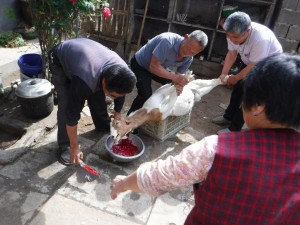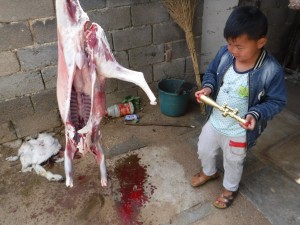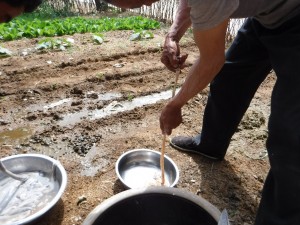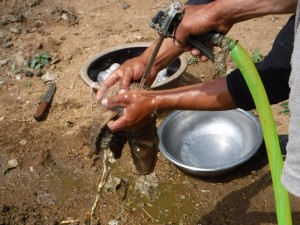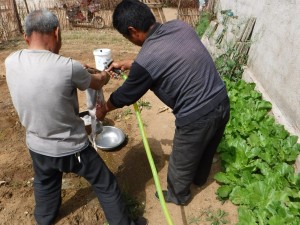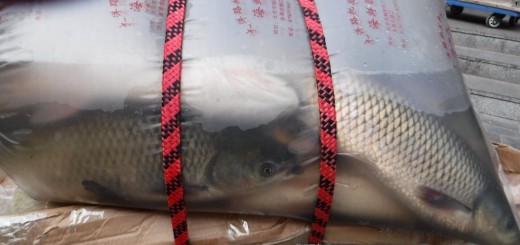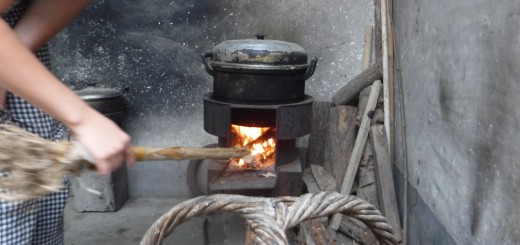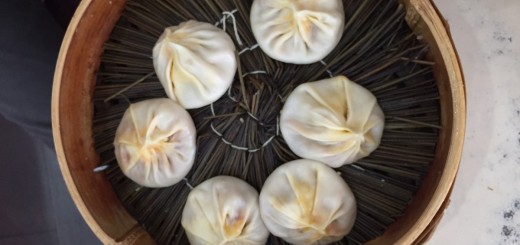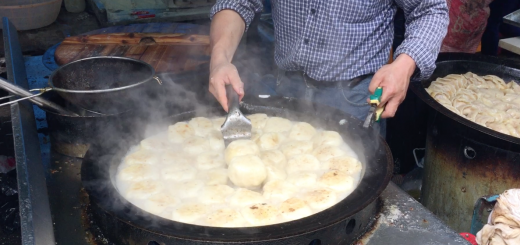Goat stew for 30
Daniel Saunders
May 10
Zhengjiazhuang village Shandong China
The day after Ze, Bonnie and I arrived at Ze’s aunts, we went to the next village up the road, past where the mountain was being blown up collected and sold with a government fee of 5 USD a ton to make tiles, past hills covered with gnarled peach and apricot trees, past the giant brick oven that used to make concrete, and into a winding little maize of alleys and stone, and brick homes with gates and gardens in front to meet the rest of the family. Ze refers to the extended family elders by title- 1st uncle, 5th uncle, 4th uncles wife etc.. It is considered rude to use the given name of someone older than you. Someone about your age you call brother or sister. On this day we were visiting The home of 4th uncle and his wife, a slow walking fast cooking woman with a kind lined face who had taken care of toddler Ze.
The family was slaughtering a goat to celebrate our visit. All the hard working uncles, aunts and cousins were taking days off to cook and eat with us. These relatives wandered into the courtyard throughout the day, always with sounds of happy reunion. After we had sipped some tea and made greeting and introductions, it was time to kill the goat.
There was a whole family of goats even some 2 day old kids living in a walled off courtyard that ran down one side of the house, but we were eating one of the most special an older male goat, the kind that could be sold locally for about 1,200 yuan (200 USD)- an expensive gesture of hospitality. Two uncles caught the goat and carried him out by his legs. His neck stretched staring wildly and yelling in an eerily human way. They pinned the goat on his side on a wooden crate while one of Ze’s cousins, a 41 year old man who makes Tofu at night and works construction by day, sharpened a knife and an aunt rinsed out a large metal bowl. The goat continued to scream, then the neck was pulled with one hand, knife stabbing with the other. The scream ended in a sudden whoosh of escaping wind and blood pouring into the metal bowl.
The aunts took the bowl of blood and let it solidify naturally. They cut it into a few large pieces and poached these gently to further bind the proteins and solidify. Next they let the blood blocks cool and sliced them into smaller pieces.
Killing and catching the blood
Outside, the cousin skinned the goat hanging from a long pole balanced against the wall. He worked with smooth slicing motions from a knife to seperate the skin at sticky spots then worked his bare hands under the skin to pull it apart on the rest. When we complimented him on his skills Ze translated back that he said he was very slow but that he was faster at slaughtering pigs. With a partner he used to process a pig skin on with all the organs cleaned in 30 minutes. This was before a government policy that requires pigs to be processed in bigger factories which put him out of his previous profession and into the tofu business. He broke through the inside of the goat’s pelvis bone to access the butt end of the digestive tract then cut down the belly and chest to reveal a bulging white spider web of caul fat, a sort of fatty net that holds the organs in place inside the body. He cut through this and, with help from an uncle, lowered the glistening jumble of stomachs and intestines into a couple big bowls. Next the cousin cut the carcass into about 9 pieces including head which were carried away. Much of the meat went into a stew we ate that day. Some was saved for dumplings we ate in the following days and some went home with relatives.
One of the youngest generation admiring the carcass
The cousin and an uncle, with a bit of help and interference from one of the sugared up youngsters who held a hose for the two men, cleaned the organs in the front garden. They cut open the stomachs and washed them very thoroughly. One had a texture like terry cloth and an incredibly intricate matrix of internal folds that were methodically peeled back and sprayed clean. All the water and poop and partially digested food went strait into a row of vegetables, young sweet potato plants I think. These nutrients from inside the goat which we couldn’t eat directly were being immediately recycled as plant fertilizer. I reminded myself this was part of the reason nearly all vegetables in China, even lettuce, were cooked with a period of high heat. The instestines were flushed with water a couple times, rolled inside out and all the cleaned organs were rubbed with salt as an anti microbial.
Cleaning the organs in the garden
the goat meat was stewed on the bone in a huge pot over a fire between two cinder blocks.When it was mostly cooked the organs were added. Then all was taken out, cut into smaller pieces then added back in with the blood pieces. After some more cooking it was ready. There were a half dozen side dishes and some bread, which, in Chinese cuisine is actually considered the main dish along with rice or noodles. Each bowl of soup was garnished with cilantro and green onion and a little dark vinegar. We ate it hot before the ample goat fat could cool. The blood was very smooth, a bit chewy with flavor of chicken thigh close to the bone. The liver head a strong almost intoxicating flavor. The meat was rich and chewy. The company was cheerful and generous.
All photos by Daniel Saunders


